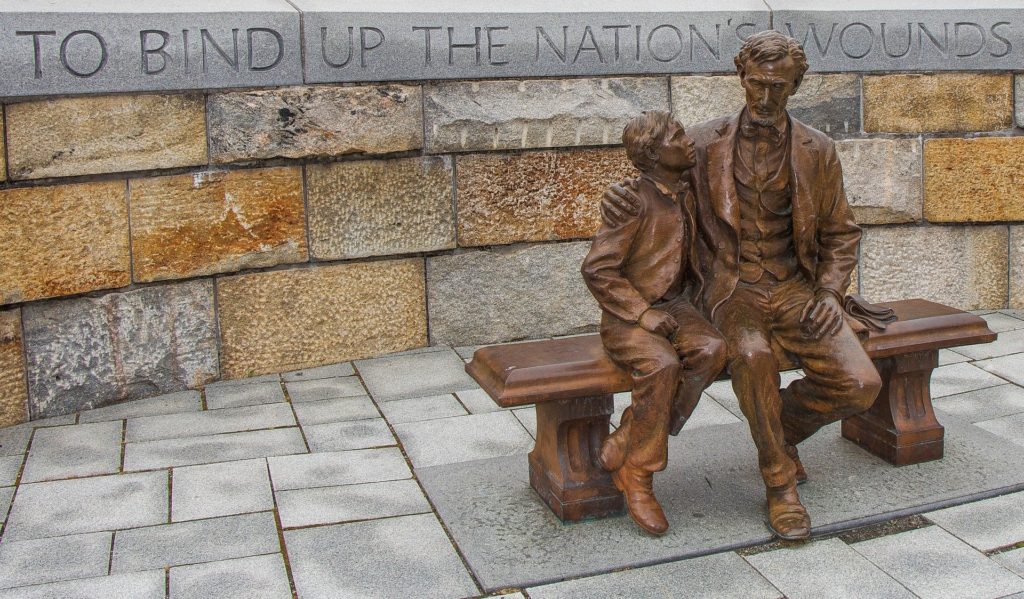According to the book by C.L. Lincoln, The Negro Pilgrimage In America, by the middle of the nineteenth century, there were sectional differences as to whether new states admitted to the Union would be slaveholding or free. The Compromise of 1850 attempted to improve relations by setting up a balanced set of conditions for the future admission of new states, and by clarifying the slave issue in the District of Columbia. California was admitted to the Union as a free state, New Mexico and Utah territories were organized on the principle of popular sovereignty, and the slave trade was ended in Washington, D.C.
The Civil War began in 1861, after decades of simmering tensions between northern and southern states over slavery, states’ rights and westward expansion. After President Lincoln was elected in 1860, seven southern states decided to secede and form the Confederate States of America. Later, four more southern states joined them. According to the book by James and Lois Horton, Slavery And The Making of America, fearful and defiant white southern slaveholders saw Lincoln’s election as a triumph for abolitionists. South Carolinians convened in a state convention in Columbia in December to consider their political future. On February 4, 1861, representatives from the seceding states established the Confederate States of America. The Confederate Constitution that was adopted in March 1861 followed the pattern of the U.S. Constitution, except that it emphasized state power over federal power and it explicitly protected the rights of slaveholders. They demanded protection by Congress and by the Territorial government in the event they acquired new territory. The southern states required the protection for slave property it felt denied under the U.S. Constitution.
When President Lincoln was inaugurated as President on March 4, 1861, the Confederate States of America were almost a month old. Former U. S. secretary of war, Jefferson Davis of Mississippi was sworn in as its president. The country broke up between the north and south and the divided states went to war.
On April 12, 1861, Confederate soldiers in Charleston Harbor opened fire on the federal Fort Sumter in South Carolina. In response, Lincoln issued a call for 75,000 volunteers to put down the rebellion. The United States seemed to have every advantage in population and resources to fight the war. Twenty-two million Americans faced a Confederate population of approximately five million free people and four million slaves. The Confederacy had important military advantages because many U.S. army officer corps, and West Point graduates, joined the rebellion against the United States. Many free Black men volunteered to fight for the U.S. but the request was denied by the secretary of war. Confederates used slave labor to support their cause. They continued to work the plantations.
During the war, people who escaped slavery in the rebellious southern states and made their way to the federal troops were considered contrabands of war. President Lincoln was reluctant to interfere with slavery. General John Freemont, military commander of the U. S. Army’s Western Department tried to free enslaved people. He declared martial law in Missouri and issued orders freeing all slaves in Confederate states. President Lincoln revoked his order and freed only the slaves who were performing direct service for the Confederacy. A new antislavery organization called the Emancipation League was dedicated to making emancipation a central aim of the war. By the fall of 1861, this League of abolitionists called for the enlistment of black troops as a necessity of war.
When the federal naval fleet attacked the Sea Islands off the South Carolina coast, the white population fled the island, leaving most of the enslaved people. The landing army found them in need of food, clothing, and medical care. Northern abolitionists and missionaries came to the area to teach, start schools and care for the people.
The war situation and the enlistment of black troops prompted President Lincoln to rethink his position on slavery. He was under pressure from the abolitionist and needed to energize northern support for the war. On January 1, 1863, he said he would issue a proclamation freeing all enslaved people under the control of people rebelling against the U.S. It was not until Congress passed the Thirteenth Amendment to the Constitution that slavery was abolished on December 6, 1965.
The Civil War, or War Between the States, ended in the Confederate surrender in 1865. This was the costliest and deadliest war ever fought on American soil. When slavery was abolished, Black people rejoiced. Authors James and Lois Horton wrote, Colonel Thomas Wentworth Higginson was moved by the thought, “It was the first time that Black people had a country and the first flag they had ever seen which promised anything to their people.”
Francie Mae. May 11, 2021.
References
James Oliver Horton and Lois E. Horton. 2005. Slavery And The Making of America. Oxford University Press, Inc. New York.
C.Eric Lincoln. November 1967. The Negro Pilgrimage In America. Bantam Pathfinder Books.
“Civil War.” History.com Editors. Website-History. https://www.history.com/topics/american-civil-war/american-civil-war-history. Accessed May 11, 2021. Publisher, A&E Television Networks. Last Updated, January 13, 2021. Original Published Date, October 15, 2009. . History.com Editors.
